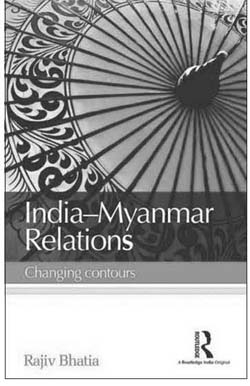Burma’s strategic importance to India cannot be underestimated. A neighbour with 1600 kms border, a number of ports facing each other across the Bay of Bengal and four traditional roads connecting the two countries and administratively linked to India under British rule, India and Burma (Myanmar) share commonalities of history, culture, religion, ethnicity and spirituality. Myanmar is the perfect economic bridge between India and China and between South and Southeast Asia. A large population of Indian origin people, estimated to be in the range of 2.5 million, lives in Myanmar. Four of India’s North Eastern States, Arunachal Pradesh, Nagaland, Manipur and Mizoram, are geographically contiguous to Myanmar. India also shares the waters of Bay of Bengal, including the area of strategically important area, Andaman and Nicobar islands, where the two closest Indian and Myanmar’s islands are barely 30 kilometers apart. Myanmar’s ports provide India the shortest approach route to several of India’s North Eastern States. Myanmar, being China’s neighbour, also provides India a transit route to southern China. It offers the landlocked regions of India and China natural gateways to the open seas and international markets. Myanmar is the largest exporter of rice and pulses to India; 4th largest trading partner of India in Southeast Asia. The trade stood at $1.5 billion a year in 2011 and it is hoped will double by 2015. The demand for Indian goods such as pharmaceuticals, electronic goods, office automation products, air conditioning equipment and vehicles etc., is high. Its oil reserves stands at 600 million barrels, and gas reserves stands at 88 trillion cubic feet. China is building 2389 kms pipeline from Kyakphu to Yunnan and imports 400 million cubic feet of gas a day from Myanmar’s offshore fields, through a direct gas pipeline that is already operational, and an oil pipeline to be completed by the end 2015, meeting 8% of its energy needs.
Rajiv Bhatia’s India-Myanmar Relations: Changing Contours analyses the complex relationship between the two countries. Of the eight chapters in the book, the first three, namely, ‘Changing Myanmar,’ sets the parameter within which the author approaches the contours of India-Myanmar relations; ‘Deciphering Myanmar: An Indian Perspective,’ looks at Myanmar society, culture, politics, economy and its foreign relations as India perceives them; and the third, ‘IndiaMyanmar Relations from Antiquity to Raj,’ that deals with the historical account of India’s engagement with Burma both before and during colonial rule when the British annexed Burma and administered it as a part of India. What is relevant from the point of view of our main theme, the evolution of India-Burma relations, is that the rise of Burmese nationalism from the first quarter of the 20th century led to the eventual separation of the country from India in 1937. The Burmese people in general developed a complex attitude toward India in which there were elements of both love and respect for Indian nationalist leaders like Gandhi and Nehru for influencing their own nationalist movement, and hostility towards the presence of the Chettiar community and their hold over valuable lands and many other Indians largely controlling the trade and commerce of the country, which led to occasional riots against the Indian community in the pre-Independence period.

